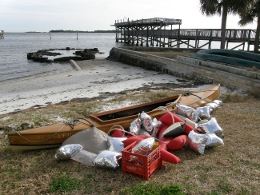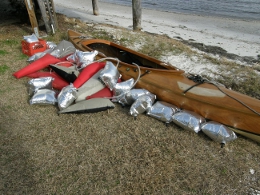Capsize Your Boat ~ Bailing and Flotation
My narrow background guides my decisions. Carefully consider your circumstances.
After I gybed back to the swamped sailing canoe at the Killbear Canoe Rendezvous in September '05, I thought of Roger Taylor's series about seamanship.
The swimming sailor's tube style pump wasn't getting it done. Wavelets instantly refilled what dozens of pump strokes had squirted out.
I sailed up, held her against Walela, and used Walela's bailer. In two dozen scoopfuls, she was left with a quart or so under the floorboards, along her ribs and lapstrake planking. Wind was offshore, and I drifted a couple boat lengths away. Her canoeist, a young man, tried again to climb in over the stern. But the boat was still too unstable, so I came back and steadied her. Just the afternoon before he'd gone over in a lighter, onshore breeze. But Lake Huron was warm, and he swam her in.
The canoe was Iain Oughtred's popular MacGregor, thirteen feet eight inches by thirty one inches. John Hupfield built her and added bulkheads fore and aft.
While I was happy to see the MacGregor's air chambers at each end, we don't use them in our decked canoes, preferring access to the whole inside.
Back home, I got out WoodenBoat issue #40, May/June 1981. Taylor had been a duty officer on a moored submarine. In the morning, the captain returning wanted to see, "his submarine still on the surface."
Taylor wrote, "Keeping the water out is not only the first and most important element of seamanship, but also it is the only necessary element of seamanship."
Naval vessels' main method is airtight "compartmentation." The MacGregor's bulkheaded off ends were its compartments. Air bags and dry gear bags are ours.
* * * * *
I'd been wondering how much bailing Walela would need if swamped with just air bags. In early October Michigan's
weather forecast was one more day of sunny 80s. So, I shoved seven flotation bags into Walela, four ahead of her mast
and three abaft the cockpit, and took her to a beach.
I was startled how readily Walela swamped as she went over. Puffin's narrower cockpit lets her lie on her side, the cockpit rim well above the water---assuming I get out fast.
With no flotation in her beam ends, it didn't take much water in Walela to push her down enough to breach the rim. She floated low on her side, stems only six inches clear of the water. When I rolled her up, she held enough lake to swim in.
Climbing over Walela's stern proved her swamped instability. Water surged inside the thirty four inch wide boat, rolling her and me like an otter. She couldn't sink or turtle due to her foam filled mast, but her centered buoyancy made an axis she wanted to roll around.
When cruising, I carry more flotation in four big, dry bags. Usually two are abaft the mast and bow air bags, and two are forward of the stern bags. But I was chagrined. I thought of lucky daysails when the dry bags weren't in there. Clearly, for day use, she wants a long, thick bubble each side, under her amidships' decks.
I quit at eighty scoopfuls from outside the boat. I climbed back up her stern using the rudder yoke as a boarding platform, hauling myself forward by the steering rods. I raised my mass two inches higher yet, over the aft spray deck for a foot and a half of deck length, then folded myself into the thirty nine inch long opening between the spray decks. Twenty spongefuls---about a quart each---left her smooth bottom barely damp.
A swamped boat should be stable, float high, and be quick and easy to bail. This time, Walela's flotation wasn't placed well. When I rolled her up, her cockpit was high enough---amidships freeboard to the sheer was about three inches, with the cockpit rim four inches above that---but she was too unstable.
If flotation is only under the decks, you won't sink, but you might be swamped for ever. If flotation is only in the ends, it won't resist rolling, or help you clamber in over the side. If it's too low and centered, it adds a capsizing moment and stability upside down. To sail away quickly, flotation must be placed widely amidships, fitting from bilge to side decks, in addition to filling the ends. The gist: secure in as much flotation as you can tolerate, to keep as much water out as you can.
I reread Taylor. He'd written, "Imagine your vessel half-full of water, and imagine how you will get it out. The quicker you can get the water out of your vessel, the better."
Keep the water out, and what does get in, get it out fast. Crucial advice, Mr. Taylor. Thank you.
Gear
 Flotation. Can you trust the air bags commonly available? Maybe half of my couple dozen from the last twenty years still hold air. The coated nylon has been perfect; one seam has a short split; but connections of hoses to fittings have failed over time. All have been past the warranty when they failed, but the glue (contact cement?) seems to let go eventually. If I could find them, I'd buy bags with higher quality fittings, like those on inflatable PFDs.
Flotation. Can you trust the air bags commonly available? Maybe half of my couple dozen from the last twenty years still hold air. The coated nylon has been perfect; one seam has a short split; but connections of hoses to fittings have failed over time. All have been past the warranty when they failed, but the glue (contact cement?) seems to let go eventually. If I could find them, I'd buy bags with higher quality fittings, like those on inflatable PFDs.
 Along with air bags and dry bags, small floating things in net bags secured in the boat work, too. Polystyrene peanuts, empty plastic film cans taped shut, water bottles, wine corks---whatever will float when needed.
Along with air bags and dry bags, small floating things in net bags secured in the boat work, too. Polystyrene peanuts, empty plastic film cans taped shut, water bottles, wine corks---whatever will float when needed.
Masts of sailing rigs should have enough buoyancy to prevent turtling. It's an argument for both large diameter masts and prudently placed flotation. Is your rig secured to the boat so it can be a drogue? Or can it, or parts of it, float away or sink?
Bailing. My hand scoop bailer is a Tide laundry detergent bottle with the bottom cut off. It's one hand operable and rectangular for scooping flat or on edge. I like the 1.2 gallon size, with the 3 quart size a minimum. The 1.5 gallon bottle is a bit too large for stowage. The plastic used for laundry detergents must be strong, long lasting, and flexible. Below freezing, I don't know. An obvious advantage of Tide, is the bright orange.
My sponge bailer is a natural "wool" sponge (Hippiospongia lachne) the biggest I can get. The sponge is the better bailer when I'm in the boat with water, loose gear, and lines, because it can grab water around or over stuff in the cockpit. Usually after a capsize, I'
d flip the seat and other tethered gear into the water or onto the deck, to clear space for bailing with the Tide bottle. Once I'm back in, the big sponge mops up. Tether your sponge, too---when wetted out they plummet.
Pumps are carried by many kayakers and small boaters. Renowned adventurer John Dowd, in his great book, Sea Kayaking, A Manual for Long-Distance Touring, relates keeping his hands free for paddling by using a foot pump moving a gallon a minute, keeping ahead of slow accumulation in his spray-skirted Klepper double. His hand pump pushed twelve gallons a minute. Some kayaks have deck mounted pumps, one hand operation, but most use a tube pump needing both hands. I carry a gray PVC tube pump, too, but seldom use it.
Sources for wool bailing sponges:
Sponge Merchant International, George Billiris, 727 938 0787, billiris@knology.net
Sponges Direct, Nick Skaroulis, 727 943 9498, sales@spongesdirect.com
Both are in Tarpon Springs, Florida. Both families have been in the sponge business over a century.
They agree hurricanes and red tide have hurt big wool sponges, which need up to ten years to grow. To help preserve a sponge, besides rinsing in freshwater, put it for a couple hours, twice a year, in a solution of water and baking soda or hydrogen peroxide. Squeeze the water out---never twist it---and let it dry out of the sun. From about $13 and shipping for a nine inch sponge to $25 plus shipping for a twelve inch sponge.
Nick Skaroulis is right. "The natural sponge is truly a wonder of nature." ~HH